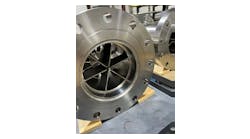Credit: NREL photographer, Jim Yost
In a new paper*, researchers at the National Institute of Standards and Technology (NIST, www.nist.gov) detailed some of the most fundamental processes involved in extracting sugars from biomass, the first step in producing ethanol by fermentation. According to the NIST, their findings should help engineers to improve their process designs in order to extract the maximum amount of fuel from a given measure of biomass, which could ultimately help make what has been a notoriously inefficient process more efficient.
Most of the ethanol produced in the United States is created by fermenting the sugars and starch found in corn. The capability to convert inedible plants and agricultural waste into usable sources for ethanol production will help to supplement alternatives to fossil fuels while reducing the diversion of food crops to energy uses, according to NIST.
Glucose can be extracted from two substances found in most plants: cellulose, the long molecule chains that comprise the cell walls of green plants, and its flimsier cell-wall counterpart, hemicellulose. The extracted glucose is then converted by fermentation to ethanol. NIST researchers, in collaboration with the National Renewable Energy Laboratory (www.nrel.gov) in Golden, Colo., have defined the theoretical limits of reactions important to cleaving, or breaking apart, cellulose and hemicellulose to produce glucose. They also determined that the energy needed to rupture these key bonds is a constant value for each molecular bond that is broken during the cleavage reactions.
According to Yadu Tewari, Brian Lang and Robert Goldberg, chemists at NIST and co-authors of the paper, cellulose and hemicellulose both present problems to would-be ethanol producers.
With enzymes to speed the reactions, the team used calorimetry and chromatography to measure the thermodynamic property values of several reactions associated with the breakdown of cellulosic and hemicellulosic substances. Because process design and bioengineering benefit from the availability of these values, the data obtained in this investigation represent a "small but significant step toward maximizing the efficiency of biomass utilization," Tewari says.
* Y.B. Tewari, B.E. Lang, S.R. Decker and R.N. Goldberg. Thermodynamics of the hydrolysis reactions of 1,4-ß-D-xylobiose, 1,4-ß-D-xylotriose, D-cellobiose, and D-maltose. Journal of Chemical Thermodynamics. Available online at http://dx.doi.org/10.1016/j.jct.2008.05.015.

